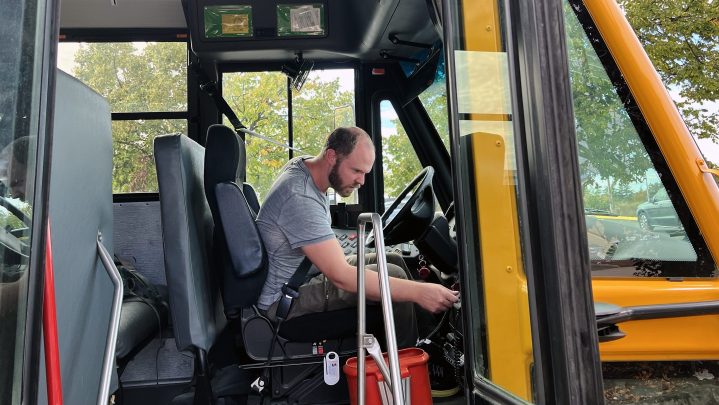
A Washington island county is trying a 32-hour workweek

From the driver’s seat of a yellow school bus with Orcas Island School District on the side, Matthew Steward is training for his newest side hustle: substitute bus driver in the San Juans, a series of lush, forested islands in Washington state that are popular with vacationers.
As Steward stops the bus in a neighborhood, an instructor reminds him what to do.
“Open your door … say ‘Quiet —’” the instructor said.
“Quiet on the bus,” Steward said. He already drives a bus for another part-time position at the YMCA, but neither of those are Steward’s main job. He’s a full-time maintenance worker for the San Juan County government.
Part of the reason he’s training for yet another side job: This month, the county government is switching most of its employees to 32 hours a week and keeping compensation the same.
Many studies have shown positive effects of the 32-hour workweek. But beyond the question of whether employers should switch, there’s the question of what might workers do with that extra day off — especially in places where the cost of living has risen faster than wages.
This small chain of islands in the Pacific Northwest is about to find out.
Steward came to Orcas Island a decade ago leading sailing trips for kids and stayed because he loves the close-knit community. Living here reminds him of living on campus at the University of Washington; he sees people he knows every block.
The next morning at work, as he drives from his office — which is shared with the local seniors center — to the public works shop, he honks at a sheriff’s deputy and waves hello.
Steward is not the only person with three jobs here. The San Juans are a haven for the wealthy; almost 40% of homes here are vacation or second homes. For everyone else, the cost of living is very high. There’s a saying on the islands: Everyone either has three homes or three jobs.
“I’ve topped out at five jobs at a time,” Steward said while replacing an air filter in one of the county buildings.
About 18,000 people live on the islands year-round. And since the pandemic, the labor shortage has hit hard here. Restaurants have closed or cut hours, and the crucial inter-island ferries are often canceled because there aren’t enough workers for the boats.

Before the new 32-hour workweek, San Juan County had upward of 30 open jobs with zero applicants, sometimes for months.
“Bringing in new people was difficult because they could be in the private sector, making so much more money,” said Cindy Wolf, chair of the San Juan County Council. “We were hurting because we were competing with that.”
County leaders realized they could offer a shorter workweek — 32 hours instead of 40 — with the same pay. That’s a huge per-hour raise. The County is one of the first local governments in the country to offer a four-day workweek, officials say.
When workers have a full extra day off each week, they sometimes take on side jobs. But a recent study shows that, more often, people spend that time taking care of their kids.
That’s especially helpful here on the islands, where child care is expensive and limited.
“There is one day care on the island that will take children from the age of 1,” said Frances Robertson, a marine biologist for the county who lives on the main island, San Juan. She’s also the vice president of the local employee union, which applauded the shorter workweek.
Robertson was lucky enough to get her kids into the one local day care that’s open from 8:30 a.m. to 5:30 p.m. But it’s still limited child care.
“They’re open four days a week, so they’re not even open five days a week,” Robertson said.
She will have some family help for her 5- and 2-year-old on the day the center is closed. So she plans to spend her newfound time doing what she loves: studying whales. It’s a regular thing to see them on the way to work or on an afternoon walk.
“There they are,” Robertson said on such a walk on a recent Monday. From a hill above the coastline, she pointed to an orca mother and calf suddenly surfacing in the water just yards from the beach.
“It’s pretty cool, hey?” she said, sounding pleased but unsurprised. “That’s pretty typical behavior of transient killer whales. They come in pretty close.”
The cost of living can make this a challenging place to live, Robertson said. But you don’t have to look far to see what makes it worth it.
There’s a lot happening in the world. Through it all, Marketplace is here for you.
You rely on Marketplace to break down the world’s events and tell you how it affects you in a fact-based, approachable way. We rely on your financial support to keep making that possible.
Your donation today powers the independent journalism that you rely on. For just $5/month, you can help sustain Marketplace so we can keep reporting on the things that matter to you.











